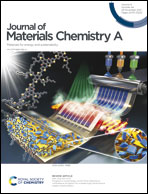Hydrogenated anatase TiO2 single crystals: defects formation and structural changes as microscopic origin of co-catalyst free photocatalytic H2 evolution activity†
Abstract
Herein we systematically investigate the influence of hydrogenation time and temperature on defects formation, structural changes, and co-catalyst free photocatalytic activity for epitaxially grown anatase thin films on strontium titanate single crystals. The photocatalytic activity trend of the anatase epi layers is similar to that of anatase powders and brookite single crystals in reported recent literature, that is, the H2 evolution rate exhibits a typical maximum upon hydrogenation under moderate annealing temperatures (500 °C). By combining surface sensitive X-ray diffraction methods and analytical high-resolution electron microscopy techniques we reveal quantitatively the oxygen loss from the epi-layer ascribed to the hydrogenation (H2 reduction) treatment. We observe specific physicochemical changes associated with the introduction of oxygen vacancies: (i) the formation of a nanoscale strained crystal surface, (ii) the agglomeration of point defects in the bulk of the anatase epi layer, and (iii) a transition towards a Ti2O3 like symmetry at the film surface, i.e. an evident oxygen deficiency at the epi layer surface in particular prominent for the most active sample as a function of the hydrogenation parameters. These extensive experimental findings allow us to propose an empirical model, which links detrimental and beneficial effects of Ti3+ centers and oxygen vacancies in the bulk and at the surface and their abundance to an optimum point defect configuration for water splitting via “grey” anatase.



 Please wait while we load your content...
Please wait while we load your content...